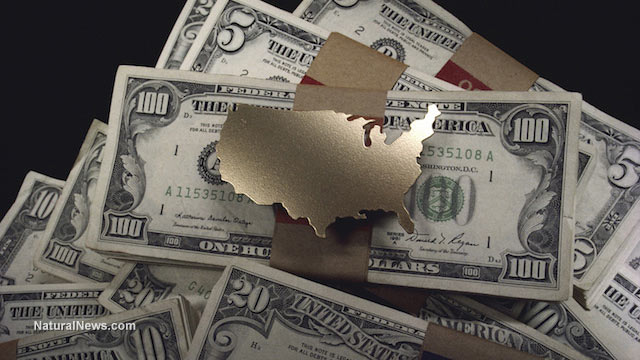$100 loses its value as you travel to states with more government control, federal data reveals
Thursday, August 28, 2014 by: L.J. Devon, Staff Writer
Tags: currency devaluation, wealth redistribution, government control

- Newly released JFK files reveal Pentagon's role in creating Lyme disease and covid in the same lab
- Trump nominates VACCINE ZEALOT Susan Monarez to lead the CDC, sidelining RFK Jr.'s reform efforts
- Trump's greatest betrayal so far: Accelerating Middle East wars, silencing dissent, and serving Zionist masters
- STARDUST, a secretive Israeli-US startup, plans risky solar geoengineering experiment to BLOCK OUT THE SUN
- $2B Roundup verdict: A landmark blow to Bayer and a win for health freedom
- Trump shows his true colors
- Festive flavors: The sweet history, nutritional profile and health benefits of pecan pie
- Elon Musk: Aliens could be here on Earth RIGHT NOW
- Dr. Mike Yeadon releases 15-minute testimony - WATCH - about genocidal intent of COVID “vaccines”
- California's social media censorship law struck down: A victory for free speech or a threat to online safety?
- HUGE: Putin claims 2020 election fraud in U.S. sparked Ukraine war, calls for peace talks with Trump
- Sugarcane extract superior to cholesterol-lowering drugs?
- “Forever chemicals” in drinking water drive alarming cancer surge, new study warns
- Chris Rufo finally reveals abuse liberals unleashed on his wife and young kids...
- Reclaim your health: How midlife exercise reverses years of inactivity
- SWEET SABOTAGE: CIA's secret war on Soviet sugar revealed in JFK files
- Pilots report mysterious lights 'moving at extreme speeds' across Oregon skies
- The forgotten hormone hero: How vitamin C quietly balances mood, stress and reproductive health
- Newly released JFK files reveal Pentagon's role in creating Lyme disease and covid in the same lab
- Elon Musk: Aliens could be here on Earth RIGHT NOW
- Reclaim your health: How midlife exercise reverses years of inactivity
- Trump reverses course on Gaza plan, says “nobody is expelling Palestinians”
- EPA advisor admits the agency is funneling billions to climate groups ahead of Trump’s return to White House
- Big Pharma's $8 Billion bribery scheme exposed: how doctors are pushed to prescribe junk science, not heal
- Space war brewing? Russia threatens to destroy Starlink satellites
- A lack of integrity in Academia: Harvard professor found GUILTY of fraudulent research to promote CRT theory
- Survival 101: Effective EMF blocking techniques
- Rep. Nancy Mace introduces bill to ban biological males from female facilities on federal property
- Mike Adams Sermon 66: God will DESTROY ISRAEL for its wickedness
- Pilots report mysterious lights 'moving at extreme speeds' across Oregon skies
- 5 Simple steps to boost your brainpower: How to strengthen executive function in a distracted world
- Historian warns Israel may be entering an “IRREMEDIABLE DECLINE”
- Florida takes a stand: DeSantis proposes permanent ban on mRNA vaccine mandates
- RFK Jr.'s SSRI antidepressant investigation sparks liberal meltdown, exposes Big Pharma's dangerous game
- OpenAI whistleblower who dissented against how the company trained ChatGPT found dead
- Sugarcane extract superior to cholesterol-lowering drugs?
- EPA advisor admits the agency is funneling billions to climate groups ahead of Trump’s return to White House
- The Health Ranger releases “Vaccine Zombie” song and music video, using AI-animated zombies for the music video
- California's social media censorship law struck down: A victory for free speech or a threat to online safety?
- Dr. Mike Yeadon releases 15-minute testimony - WATCH - about genocidal intent of COVID “vaccines”
- The pandemic as a tool for INDOCTRINATION: Understanding “The Indoctrinated Brain” by Dr. Michael Nehls
- Mike Adams releases country western hit single: Goin’ Back in Time is Comin’ Home
- Mike Adams releases music poetry sensation: A Child of God
- RFK Jr. clears key hurdle: Sen. Susan Collins backs controversial HHS nominee, signaling a new era for health policy
- Florida takes a stand: DeSantis proposes permanent ban on mRNA vaccine mandates
- Unpacking the Lies That We’ve Been Fed – new song and music video released by Mike Adams, the Health Ranger
- Mike Adams releases new song and music video: Nothing More Disgusting Than a Globalist
- Congratulations to the FULLY UNVACCINATED as you resisted the COVID-19 PROPAGANDA MACHINE fueled by over $100 BILLION
- “Why we influenced the 2020 elections”: Facebook files reveal the coordinated effort to bury the Hunter Biden laptop story
- Michigan sheriff announces criminal investigation into 2020 election crimes, Dominion Voting Systems
- Israeli soldiers accused of even more torture and abuse in the West Bank
- Migrants are taking advantage of recent hurricanes to scam residents and loot their homes
- House Intelligence Committee calls for the ARREST and PROSECUTION of Dr. Anthony Fauci
- Peter Rost exposes Big Pharma corruption in his book “The Whistleblower: Confessions of a Healthcare Hitman”
- Red Cross issues warning to stop blood plasma donations from vaccinated people
- Scientists confirm: GENIUS brain function can be spontaneously unleashed in humans without any apparent cause
- EPA advisor admits the agency is funneling billions to climate groups ahead of Trump’s return to White House
- HYSSOP: What research reveals about the health benefits of this ancient holy herb
- Two containers with completed ballots fall out of truck in Florida
- Fully vaccinated about to see “tsunami” of illness and death, warns virologist
- Global leaders unite to clamp down on “misinformation” with UN-backed Cascais Declaration
- BREAKING: 2025 NDAA authorizes mandatory military draft of WOMEN across America… as Pentagon pursues global NUCLEAR war with both Russia and China at the same time
- Michael Yon warns of a ZIONIST TAKEOVER in Trump’s second administration
- BOMBSHELL: DNA testing kits are a SCAM to develop ethnic-specific bioweapons
- Ozempic and Wegovy weight loss drugs are injectable LIZARD VENOM PEPTIDES that may unleash a devastating wave of organ failure… side effects align with symptoms of SNAKE BITES
- Israeli soldiers accused of even more torture and abuse in the West Bank
- These 13 countries just signed an agreement to engineer a global FAMINE by destroying food supply
- NASA admits that climate change occurs because of changes in Earth’s solar orbit, and NOT because of SUVs and fossil fuels
- RFK Jr. clears key hurdle: Sen. Susan Collins backs controversial HHS nominee, signaling a new era for health policy
- Sermon 30: How Jesus reveals Caesar’s FAKE CURRENCY and FALSE AUTHORITY
- Coriander seeds: Ancient medicine backed by modern science
- Arizona officials claim Maricopa County needs 10-13 days to tabulate results of the election
On a state-by-state basis, places like New York and California are often viewed as more financially opportunistic, providing higher-paying jobs. It turns out, however, that states like these are actually more economically challenged, making it harder for families to get the most out of their income. Using data from the Bureau of Economic Analysis, the Tax Foundation compiled data from 2005 through 2009 showing the real purchasing power of personal income per capita. They compared New York with the state of Kansas. In nominal dollars, New York appears richer, boasting $47,000 per capita to Kansas' $39,000 per capita. After the real purchasing power of the dollars was adjusted per capita using the Consumer Price Index, the value of money earned in Kansas surpassed the value of New York money. New York fell to $40,000 per capita, while Kansas rose to $45,000 per capita.
New bipartisan data reveals how far $100 will go in each state
In conjunction with this data, the Tax Foundation compiled federal data from all 50 states to reveal regional price variations. The group composed a map showing just how far $100 goes in all 50 states. The map shows the value of goods that $100 can buy in each state, compared to the national average. These regional cost differences were released by the Bureau of Economic Analysis for the first time ever in April 2014, showing the real strength of each economy. Consumer Price Index information was figured in for expenses such as coffee, cereal, fuel, clothes, airline fares, hospital stays, college tuition, funeral expenses and sporting event tickets.The data revealed a striking pattern. The places where government intervenes in the economy the most are actually also where $100 is worth the least. Among these were the District of Columbia ($84.60), Hawaii ($85.32), New York ($86.66), New Jersey ($87.64) and California ($88.57).
States in the middle of the pack included Illinois ($99.40) and Florida and Oregon ($101.21).
Still, there were at least 30 states ranking higher than these, where a $100 bill is worth more than the national average. The best economies are in the heartland and throughout the southern United States.
The states where $100 was worth the most (compared to the national average) included states with minimal government intervention in their economy. These states included Mississippi ($115.74), Arkansas ($114.16), Missouri and Alabama ($113.51), and South Dakota ($113.38).
Government intervention into the economy diminishes the relative purchasing power of dollars
This shows that $100 in a place like Washington, D.C., would only provide $85 worth of food, while buying nearly $116 worth of groceries for someone living in Mississippi. That's roughly a 30 percent difference! This is the first set of data revealing how wealth redistribution programs actually destroy the relative value of currency for everyone. Using government to take from one to bail out another apparently raises taxes and cost of living for all, inflating the cost of consumer goods, from healthcare to food. These states, where government intervenes "on behalf of the poor" are actually the poorest states, where dollars are worth less for everyone. As the Bureau of Economic Analysis reveals, $50,000 in New York is really worth just $43,000 after accounting for taxes and higher cost of living. For a state like Oklahoma, the $50,000 actually feels more like $56,000.View the map here.
Sources for this article include:
http://www.dailymail.co.uk
Currency devaluation at FETCH.news
Get independent news alerts on natural cures, food lab tests, cannabis medicine, science, robotics, drones, privacy and more.
Take Action: Support Natural News by linking to this article from your website
Permalink to this article:
Embed article link: (copy HTML code below):
Reprinting this article:
Non-commercial use OK, cite NaturalNews.com with clickable link.
Follow Natural News on Facebook, Twitter, Google Plus, and Pinterest
Science News & Studies
Medicine News and Information
Food News & Studies
Health News & Studies
Herbs News & Information
Pollution News & Studies
Cancer News & Studies
Climate News & Studies
Survival News & Information
Gear News & Information
News covering technology, stocks, hackers, and more



"Big Tech and mainstream media are constantly trying to silence the independent voices that dare to bring you the truth about toxic food ingredients, dangerous medications and the failed, fraudulent science of the profit-driven medical establishment.
Email is one of the best ways to make sure you stay informed, without the censorship of the tech giants (Google, Apple, Facebook, Twitter, YouTube, etc.). Stay informed and you'll even likely learn information that may help save your own life."
–The Health Ranger, Mike Adams













































